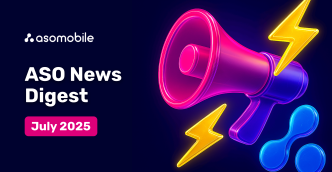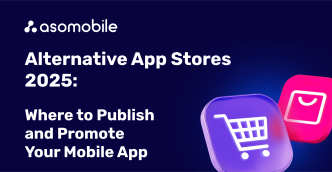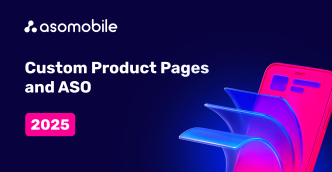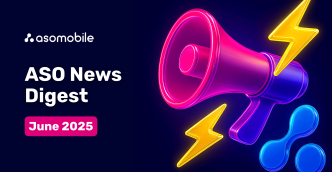Custom Product Pages and ASO optimization
Custom Product Pages in the App Store are among the most powerful ASO tools for personalization and conversion growth in 2025. Let’s explore how they work, where to use them effectively, how to distinguish CPP from Product Page Optimization (PPO), and why the significance of their ASO is growing.
Since the release of iOS 15, Custom Product Pages (CPPs) have become a staple in the ASO toolkit. They allow you to create multiple versions of your app’s product page with unique visuals and text tailored to specific audiences, keywords, or ad campaigns.
In 2025, CPPs gained new momentum thanks to tighter integration with Apple Search Ads, as ad variations based on CPPs enable precise targeting, reduce the cost per install (CPI), and boost conversions. While CPPs were primarily used in paid campaigns until now, the ability to link them to organic keywords transforms them into a full-fledged ASO strategy tool. However, it’s essential to remember that CPPs are not traditional A/B tests, such as Product Page Optimization. Instead, they serve as a source of insights and a means to personalize the user experience, rather than a tool for random hypothesis testing. Let’s explore how to get the most from Custom Product Pages in a competitive and ever-evolving App Store environment.
CPP – Custom Product Pages in the App Store
The App Store allows you to create up to 35 Custom Product Pages (CPPs) for a single app. Each can include unique screenshots, promotional text, and app previews tailored to specific audiences or campaign goals.
Each CPP has its unique URL, enabling precise control and tracking of traffic sources. This is especially valuable when working with Apple Search Ads, as users can be directed to different product pages that best match their interests and search intent through various ad variations.
All CPP performance metrics—from views to installs and conversions—are available in App Store Connect. This means we can analyze which creatives perform best and optimize campaigns based on actual data. We’ll explore how to evaluate CPP performance in more detail below.
In 2025, Custom Product Pages are no longer just a personalization tool — they are a key part of advertising strategy, supporting seasonal campaigns, feature promotions, and even lowering CPI through more relevant messaging. The core benefit is paid user journey personalization, which can also serve as the basis or inspiration for future A/B tests. While CPPs are not intended for classic A/B testing like PPO, they allow us to measure audience reactions to specific creative approaches. Now let’s break down how to create Custom Product Pages and what to pay attention to.
CPP creation (Custom Product Page)
Creating a CPP starts in App Store Connect.

You can:
- either duplicate the default product page,
- or start from scratch — ideal if you want to test unique creatives for a specific audience.
It’s essential to assign a clear, descriptive name to each CPP (based on geo, campaign type, etc.) to simplify future analysis and management.

Next, you configure visual and textual elements — we’ll discuss optimization strategies later.
All submitted metadata must pass Apple’s review. You can submit a CPP for review independently of app updates, which speeds up the campaign launch process.
Note: While a CPP is under review, you cannot edit its elements. However, you can cancel the submission, make changes, and resubmit.

Thus, we receive structured traffic to our CPPs and assess how well our creatives perform within the context of a specific user audience.
New in 2025: Deep Links in CPP
Starting with iOS 18 and iPadOS 18, you can assign a deep link to each CPP, directing users to a specific screen or feature rather than just opening the app’s main page. This streamlines navigation and shortens the path from click to action, boosting both retention and user satisfaction.
Example: If you promote a seasonal travel bundle, the user is directed directly to that section within the app, bypassing the main menu.
CPP in Marketing: Precise Targeting
Once published, each CPP receives a unique URL, which can be used in:
- Apple Ads
- Email campaigns
- Social media
- Blog content
- Push notifications
This enables you to target users with tailored content, track behavior by traffic source, and adapt pages to users' interests.
Custom Product Pages are more than just App Store listings—they are a personalized touchpoint that boosts both ad performance and conversion rates. But how can we harness their potential for ASO?
ASO optimization of CPP
If your goal is to align creatives with the needs of your target audience, ASO efforts should focus on optimizing the customizable elements, such as screenshots and app previews.

Within each CPP, you can optimize:
- Screenshots
- App Preview Videos
- Promotional Text (up to 170 characters)
These are key visual ASO elements. They shape first impressions, set user expectations, and have a direct impact on conversion rates.
App Preview — dynamic feature presentation
App Previews are short videos that highlight key app features without requiring installation. In CPPs, these videos can be adapted for specific audiences:
- For gamers — emphasize gameplay
- For business users — show interface and practical value
- For moms — highlight simplicity, safety, and support features
Example: In a health tracking app, you can showcase different scenarios, such as sleep monitoring, menstrual cycle tracking, or stress levels, depending on the keywords targeted by the campaign.
Screenshots — visual keys for every audience
Screenshots act as visual messages tailored to each segment. CPPs are ideal for offering several customized versions, each speaking the visual language of its audience:
- Simplified UI for older users
- Bright colors and gamification for Gen Z
- Selfie-editing tools for Asian markets
- Route/navigation features for European travelers
Use bold captions (CTAs, benefits) aligned with the user’s search intent.
Promotional Text — communicate value instantly
170 characters is your chance to convey a strong value proposition, trigger curiosity with a seasonal offer, or highlight a new feature.
2025 Tip: Use high-frequency keywords in the promotional text with an exact match to the user's search trigger or campaign theme.
Geo-localized example
Suppose you’re promoting a photo editor through a Custom Product Page:
- For Asia, focus on selfie features, skin-smoothing filters, and social video effects
- For Europe 40+, highlight landscape editing, architecture tools, and automatic enhancement
This approach increases engagement and reduces CPI by immediately showing a relevant offer.
2025 Update: CPP now supports organic search
Custom Product Pages (CPPs) can now be linked to organic keywords, not just Apple Search Ads.
Why this matters for ASO:
- CPPs are no longer limited to paid traffic
- Keyword placement strategy must be rethought (title, subtitle, keyword field)
- Targeting complex keyword combinations may be difficult due to exact-match rules
- The 35-page limit remains, so each CPP must be used efficiently
ASO for CPP: Summary
ASO for CPPs isn’t just about changing screenshots. It’s about precise alignment with user expectations that a single universal page can’t deliver.
In 2025, personalized ASO based on creative variability, segmentation, and smart testing delivers the best results for conversion and retention.
Strengths and limitations of Custom Product Pages in 2025
CPP Advantages:
- Audience segmentation: create versions tailored by geography, gender, interests, or keywords
- Conversion growth & lower CPI: personalized visuals raise install probability
- Marketing flexibility: use CPPs for seasonal promos, updates, and branding
- Deep link support (iOS 18+): send users directly to app content
- Visual A/B testing: test creatives to inform main page updates
- Apple Ads synergy: boost ad relevance, control message, capture brand/competitor traffic
CPP Challenges:
- Resource-intensive: requires time, localization, creative assets, and analysis
- Testing limitations: CPPs aren’t proper A/B tools unless ad groups are perfectly structured
- No editing during review: must finalize creatives before submission
- Not a PPO replacement: CPPs don’t show variants randomly in organic search — they’re not designed for pure hypothesis testing
How to evaluate CPP performance
You can measure CPP results in App Store Connect and Apple Search Ads by comparing performance with the default product page.
Metrics include:
- Impressions & views
- Installs
- Conversion rate (CVR)
- CPI (when used with ads)
- Traffic sources & behavior by segment
CPPs offer insight into which page variations drive installs and higher user value.
Note: CPPs ≠ A/B testing. You define what is shown to whom. If results fall short, the issue might be the targeting or messaging — not the creative idea itself.
Example: A sports app running All-Star Game creatives on a CPP will likely convert better among basketball fans than a generic page.
Key insight: Align the traffic source with the message
CPPs allow you to harmonize the entire user path — from ad click or search term to tailored messaging and visuals. When everything aligns, conversion rates rise and drop-off decreases.
Ongoing analysis helps:
- Identify high-performing pages
- Scale winning creatives
- Adapt the main product page using insights from CPPs
Understanding CPP performance means understanding user behavior across segments. In 2025, it will be a cornerstone of Apple Ads and personalized ASO.
CPP vs PPO: What’s the difference?
Custom Product Pages (CPP) and Product Page Optimization (PPO) serve different goals.
CPPs:
- Up to 35 versions
- Unique screenshots, videos, and promo text
- Each has a shareable URL
- Used in ads, emails, content marketing, and segmented campaigns
- As of 2025, it will also be used in organic keyword targeting
- Help match the message to the user, increasing ad and keyword conversion
PPOs:
- Classic A/B testing for organic traffic
- Apple randomly splits users between variations
- No URL control
- Ideal for evaluating which visuals work best organically
- Data includes all traffic sources: search, browse, and Today tab
CPP as a personalization and ASO tool
Custom Product Pages aren’t just alternative app listings — they’re touchpoints for personalized engagement.
In 2025, they shine when combined with Apple Search Ads:
- Boost relevance
- Lower CPI
- Strengthen branding and messaging consistency
Analyzing CPP data helps:
- Identify keyword–page matches
- Add high-performing terms to metadata
- Improve the main app listing with top creatives from CPPs
Remember: CPPs enhance ASO, but don’t replace it.
 Українська
Українська  Русский
Русский  Español
Español 






